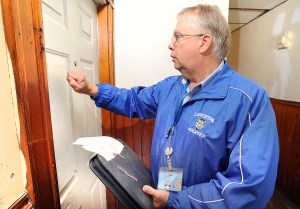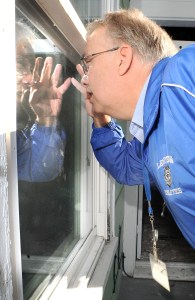LEWISTON — Knock, knock, knock.
No answer.
Two hours after the school day started, Lewiston School Department Truant Officer Butch Pratt stood on the porch of a Sabattus Street apartment wearing a Blue Devils jacket and an ID badge.
He knocked again.
No answer.
“My guess is they’re not going to open the door,” Pratt said. “I left my cards twice last week. I tried calling this morning and left messages on two phones. I haven’t heard back.”
The truant student he was looking for that April morning earlier this year — which was day 135 of the school year — had missed 49 days.
The curtain on the porch door moved. A young girl opened it. With a soft demeanor, Pratt explained why he was there. The girl closed the door. A moment later Pratt was invited in by the mother.
The mother told him her child was not in her Geiger Elementary School classroom because other students were picking on her. “You don’t know why. She didn’t report it,” Pratt said. “She just stopped going to school.”
The woman yawned frequently, to the point that Pratt wondered whether she was taking in the message of how critical it was for her daughter to go to school. “Maybe she was up all night,” he said.
Pratt returned to his car, made a few notes on his clipboard and drove to the next address.
He knocks on doors every day, trying to find parents and encourage them to get their children to school.
“Today, Butch had to go get a 9-year-old out of bed to go to school,” Lewiston Superintendent Bill Webster said this past Monday. “Last week, he had to get a 7-year-old.”
A first-grade boy missed 60 days of school, Webster said, “because mom couldn’t get him out of bed.” A high school student “comes to school once a week so his family can continue to get Social Security support.”
Though truants make up a small minority, there is a cost, he said.
“Clearly, 95 percent of our students are doing well in attendance, but even 5 percent truancy is way too high,” he said. “To have 5 percent of every graduating class be unsuccessful is a tremendous cost.”
Schools are judged on attendance, Lewiston’s Webster said. Lewiston High School was downgraded in its letter grade from C to D because of the lack of attendance on one test on one day, Webster said. Developing a culture in which all students attend school regularly “is critical, both for students and society.”
Too many not in school
The Lewiston School Department has created multiple programs to help more students graduate from high school. Lewiston’s dropout rate has declined, and the number of students who graduate in four years improved from 60 percent in 2008 to 71 percent in 2012.
“But at this point, I haven’t seen any evidence we are making a dent in truancy,” Webster said. “I’m concerned it may be getting worse. When a first- or second-grader misses 40 to 50 days in a year, it’s a parent issue.”
Webster said Lewiston is doing a better job of tracking truancy, although it doesn’t have hard numbers to indicate the direction of the problem. But, “increasingly we’re finding parents who don’t have the skills to parent,” Webster said.
A truant student isn’t one who misses a day occasionally. State law defines truants as students between the ages of 7 and 17 who have seven to 10 days of unexcused absences.
While not alone with a truancy problem, Lewiston has a higher percentage than some other communities, which is tied to Lewiston’s high number of students living in poverty. Research shows poor students are more likely to be chronically absent at young ages.
On a typical day in Lewiston, 5 percent — 250 of the city’s 5,200 students — are truant: 150 elementary students and 100 middle and high school students. In Auburn in 2012-13, according to Superintendent Katy Grondin, 46 of 3,600 students were truant, a rate of less than 1.5 percent.
In Cumberland County, 4 to 8 percent of elementary students missed 18 or more days of school from 2010 to 2012, according to Spurwink Services of Portland. That translates to 850 students who missed 10 percent or more of the year in the past two years, according to Spurwink. The South Portland school district also is working to improve student attendance.
Chronic absences affect everyone in the class and can trigger further problems in middle and high school, according to the Maine Department of Education.
Daily attendance is key for school success, said Rachelle Tome, DOE’s chief academic officer. When a young child misses 10 percent of the school year for any reason, it can leave the student unable to master reading by the end of the third grade, giving that child a higher risk of becoming a high school dropout, Tome said.
A daily list from Lewiston High School showed 109 truant students — 9 percent of the school’s population — on an April day earlier this year. Nearly half had missed 24 or more days. Three had missed 100 days or more, with two months left in the year. Lewiston’s school year is 175 days.
A parenting problem
Legally, it is parents’ responsibility to get their children to school. The vast majority do.
But increasingly, parents of truant students don’t have high enough expectations of their children in terms of chores and going to school, Webster said. “They don’t want to fight the battle.”
Parents, often single mothers, find it easier to let the child stay home, or the parent has trouble getting herself out of bed, Webster said. “They may not even be at home. They may be working.”
In those households, education is not a high enough priority, he said.
Some of the parents of truant students didn’t finish school themselves. “They became parents at young ages,” Truant Officer Pratt said. “They were kids of parents who didn’t finish school and became parents at a young age.”
In those families, “the younger kids look at the older ones and say, ‘He doesn’t have to go to school. Why do I have to?’ After a while that becomes the norm.”
At one home visit, Pratt knocked on the door of a third-floor downtown apartment to ask a mother about her truant first- and fifth-graders.
Two men who appeared to be in their 20s or 30s came out and walked to the porch to smoke. Pratt went inside and talked to the mother. Afterward, he said adults in the household had something going on with a missing friend. The adults were not in a good frame of mind, he said. “Kids pick up on that.”
The mother told him she’d do a better job of calling the school when her sons were sick. She acknowledged there were a couple of days when one stayed home and he shouldn’t have. Her first-grader “gives her a hard time about going to school,” Pratt said. “This little guy has issues, nobody liking him.”
Experts say the more children miss school, the more difficult school becomes. Truant students miss lessons that put them behind academically, and they aren’t building relationships with peers. “Failure becomes a self-fulfilling prophecy,” Webster said.
Occasionally, Pratt’s message sinks in. He sees successes, including a young woman he used to chase for being truant. She dropped out of high school, then got her GED, is working, paying taxes and taking college courses.
But in too many cases, students start missing school in the early grades. “You’ll follow them right through elementary, middle school and through high school,” Pratt said. “They’ll go less and less. It’s almost like they don’t see hope. There’s no drive, nobody to look up to. It’s not there.”
‘Lifelong sentence of no success’
Schools have limited ability to address truant students, Pratt said.
Under state law, the parent is the one in violation, not the student. If he sees a truant 15-year-old at the skate park, he or police may ask the student if he or she should be in school.
“He may say, ‘Yeah I should,’” Pratt said. “You say, ‘Think you might want to go?’ He’ll say, ‘No, I don’t.’ They’re not in violation of anything. It’s frustrating. I have no authority to pick them up.”
Even if he did, he’d bring a student to school who didn’t want to be there. “He’s in class with other kids who want to be there. Now they have to listen to one who doesn’t want to be there.”
Parents of truants can be, and sometimes are, referred to the Maine Department of Health and Human Services. They can be brought into court, face a civil violation, be fined $250 and be made to explain to a judge why their student has missed so much school.
The judge may order the family to undergo counseling, “but it doesn’t get to the real crux,” Pratt said. Typically, the parent waits for the state check to arrive, pays the $250 fine, “then the kid’s not in school. We’re right back to square one. Unless that kids wants to learn, it’s an uphill battle.”
Webster said he’s not giving up.
Lewiston’s truant officer will continue knocking on doors. Educators will continue to try to meet the needs of individual students to make school a place they want to be. And the school will continue to bring the parents of truant students to court.
Webster hopes to build a community culture that acknowledges the importance of attending school every day, starting with a “Lewiston Unites” meeting on Sept. 25.
He also plans to call attention to the need to change state law to better allow districts to deal with the problem, starting with an October conference of the Maine School Management Association.
There should be consequences for truancy beyond the parent’s $250 fine, Webster said. Maybe the right to have a driver’s license shouldn’t be given if a student is truant, he said.
Also, under the current law, attendance is not required until a child is 7. Many children attend public preschool at age 4, kindergarten at 5, first grade at 6, second grade at 7. “So a child could miss many days but not be deemed truant,” Webster said.
Doing nothing to address the problem would be a disservice to children “who have no means to correct the situation themselves,” Webster said. “Ultimately, if a child is not in school, we’re committing that child to a lifelong sentence of no success.”
Expert: Why daily attendance is important
AUGUSTA — More than ever, daily attendance is key in school success, said Rachelle Tome, chief academic officer for the Maine Department of Education.
Today’s classrooms are more interactive, with hands-on activities to enhance instruction. Those activities can’t be made up.
“Students who miss school, even for family vacations, lose the opportunity to participate in these rich learning experiences,” Tome said. “When students do return from missing several days of school, they often find themselves in catch-up mode. This can create a challenge for the student, who may now feel out of sync with peers, but also the teacher, who may need to take time away from working with the whole class.”
Frequent absences can create a snowball effect, Tome said. “They fall behind due to absences, excused or unexcused. They have difficulty catching up. They feel like school is getting too hard and try to find ways to stay home, or actually become physically ill.”
For older students, this can lead to truancy problems or dropping out.
In a “Getting Kids to Show Up” program given to southern Maine schools last Tuesday by the Maine Department of Education, experts said poor school attendance is a root cause of low achievement.
DOE experts recommend schools, families, community agencies and businesses address chronic absenteeism and increase academic achievement through data-based strategies and community partnerships.
School attendance should be marketed as a community issue, according to the DOE. Community agencies should partner with schools to work with families and students who are chronically absent.







Comments are no longer available on this story